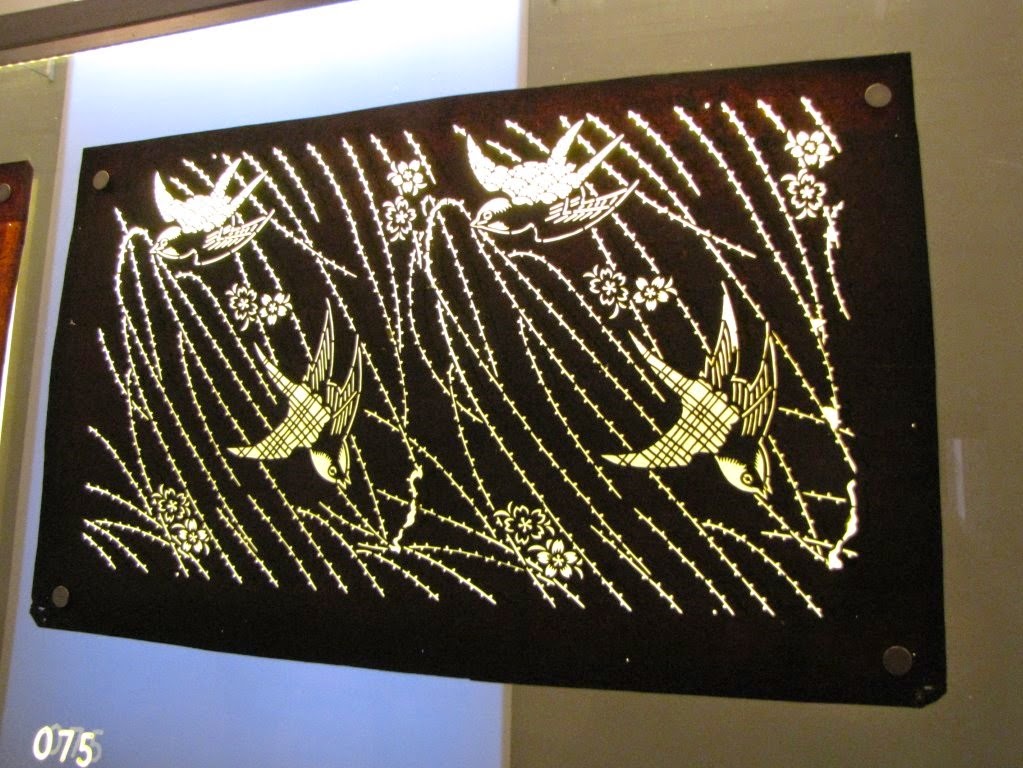Bevor die
Ausstellung zu Ende geht, ein kleiner Einblick mit Fotos. Für mich war es sehr informativ, da ich einen Kurs ‚Kesa‘
bereits besucht hatte.
Flickwerk zur ErleuchtungDas buddhistische Mönchsgewand
22. August 2014 – 22. März 2015
Im japanischen Buddhismus spielt der aus Flicken zusammengenähte Umhang (jap. kesa) eine wichtige Rolle. Grundsätzlich steht das 'Flickwerk' für das Nichtanhaften an die Welt und für Armut. Der kesa wird in Japan zudem als Symbol der buddhistischen Lehre gesehen und er wird als Zeichen für das vollkommene Verständnis der Lehre vom Lehrer an den Schüler weiter gegeben. Doch auch in der Politik wurde dieser Umhang eingesetzt: Verliehen durch den Kaiser wurde mit dem kesa nicht nur die klerikale Macht des Abtes befördert, damit waren auch weltliche und steuerliche Privilegien für das Kloster verbunden.
Aus den Beständen des Museums, ergänzt durch namhafte Leihgaben, werden buddhistische Textilien und Statuen gezeigt. Die thematische Vielschichtigkeit des Umhangs reicht vom Symbol der buddhistischen Lehre, Bestandteil des klösterlichen Zeremoniells über das Zurschaustellen von Macht und Einfluss bis hin zur Herstellung als kontemplative Praxis.
Ausstellung
22.8.2014 – 22.3.2015
FLICKWERK
ZUR ERLEUCHTUNG Das buddhistische Mönchsgewand
MUSEUM DER KULTUREN BASEL
Anlässlich des Jubiläums «150 Jahre diplomatische Beziehungen zwischen Japan und der Schweiz» zeigt das Museum der Kulturen Basel die Sonderausstellung «Flickwerk zur Erleuchtung - das buddhistische Mönchsgewand». Der japanische Buddhismus hat verschiedene Formen von Mönchsgewändern, den so genannten kesa, entwickelt. Ein kesa besteht aus rechteckigen Stoffstücken, die von Hand zusammengenäht sind. In diesem ‹Flickwerk› entfaltet sich ein Kommunikationssystem mit eigener Grammatik und Symbolsprache.
Es steht für das Nichtanhaften an die Welt und für Armut. Der kesa wird als Symbol der buddhistischen Lehre gesehen, er wird als Zeichen für das vollkommene Verständnis der Lehre vom Lehrer an den Schüler weiter gegeben und seine Herstellung ist bis heute Teil buddhistischer Praktiken. Schliesslich sind kesa historische, textile Belege für die Öffnung Japans und den wirtschaftlichen und kulturellen Austausch mit dem Westen.
In der Ausstellung werden nahezu 40 kesa in unterschiedlichen Formen, Herstellungsweisen
und Materialien gezeigt – vom einfachen Leinen bis zur kostbaren Seide. Es werden einzigartige Objekte aus den eigenen Beständen des Museum zu sehen sein, zum Beispiel eine geheimnisvolle, sehr seltene yamabushi-Figur (Bergkrieger)
oder ein aufwendig restaurierter kesa aus dem 18. Jahrhundert sowie weitere buddhistische Textilien und Skulpturen. Namhafte Leihgaben aus dem Musée Guimet Paris, dem Textilmuseum St. Gallen, der MCH-Stiftung Sammlung Hammonds und aus Privatsammlungen bereichern zusätzlich diese faszinierende Ausstellung.
Before the
exhibition expires, a little insight with photos. For me it was quite
informative, because I visited a workshop ‘Kesa’ already.
From Patchwork to EnlightenmentThe Buddhist Monk's Robe
August 22, 2014 – March 22, 2015
In Japanese Buddhism, the monk's robe (kesa), pieced together from sundry patches, plays a significant role. Basically, the patchwork stands for the non-adherence to worldly things and for poverty. In Japan, the kesa is also regarded as a symbol of Buddhist teaching and is bestowed upon a pupil by his master to mark that he has gained full understanding of the teachings. The robe also played an important part in politics. It was given by the emperor to an abbot of a monastery as a sign of clerical power and brought with it a range of secular and fiscal privileges.
On display in the exhibition are Buddhist textiles and statues from the museum's collections supplemented by a few extraordinary loan pieces. The layers of meaning that the robe conveys reach from being a symbol of Buddhist teaching to representing the monastic ceremonial life, implying power and influence and constituting the foundation of contemplative practice.
Exhibition 22.8.2014 - 22.3.2015
FROM PATCHWORK TO ENLIGHTENMENTThe Buddhist Monk’s Robe
MUSEUM DER KULTUREN BASEL
To mark the anniversary “150 Years of Diplomatic Relations between Japan and
Switzerland”, the Museum der Kulturen Basel is presenting the exhibition “From
Patchwork to Enlightenment - The Buddhist Monk’s Robe”.
Over the centuries, Japanese Buddhism has seen the emergence of different types
of monk’s robes, so-called kesa. The garment consists of rectangular pieces of
cloth sew together by hand. The “patchwork” forms a communication system in
its own right, with a grammar and a symbolic language of its own. It stands for
non-adherence to worldly things and for poverty. The kesa is also regarded as a
symbol of Buddhist teaching and is bestowed by a master upon his pupil to mark
that the student has attained full understanding of the doctrine. Creating a kesa is
part of Buddhist practice up to this day. Last but not least, kesa are a testimony
to the country’s historical opening and the start of economic and cultural exchange
between Japan and the West.
On display in the exhibition are roughly forty kesa of different shape, make and
quality – from simple linen to precious silk. Among others, it includes unique
items from the museum’s own collections, for example, a mysterious, very rare
yamabushi figure (mountain warrior), an elaborately restored kesa from the
eighteenth century and various other Buddhist textiles and sculptures. Extraordinary
loans from the Musée Guimet Paris, the Textile Museum St. Gallen, the
MCH-Stiftung Collection Hammonds and various private collections complement
this fascinating exhibition.
Einige Bilder von
meinem Fotografen.
Some pictures taken by my photographer. 






















.jpg)


























































